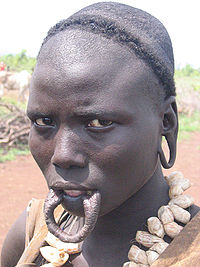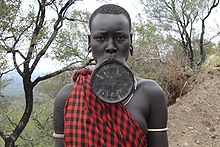- Mursi people
-
Mursi 
Regions with significant populations Ethiopia Languages Religion Animist
Related ethnic groups The Mursi (or Murzu) are a Nilotic pastoralist ethnic group that inhabits southwestern Ethiopia. They principally reside in the Debub Omo Zone of the Southern Nations, Nationalities, and People's Region, close to the border with South Sudan. According to the 2007 national census, there are 7,500 Mursi, 448 of whom live in urban areas; of the total number, 92.25% live in the Southern Nations, Nationalities, and People's Region (SNNPR).[1]
Surrounded by mountains between the Omo River and its tributary the Mago, the home of the Mursi is one of the most isolated regions of the country. Their neighbors include the Aari, the Banna, the Bodi, the Kara, the Kwegu, the Me'en, the Nyangatom and the Suri. They are grouped together with the Me'en and Suri by the Ethiopian government under the name Surma.
Contents
Language
The Mursi speak the Mursi language as a mother tongue. It is classified as Surmic, which is a branch of the Nilo-Saharan language family. Mursi is closely related (over 80% cognate) to Me'en and Suri, as well as Kwegu. According to the 1994 national census, there were 3,163 people who were identified as Mursi in the SNNPR; 3,158 spoke Mursi as their first language, while 31 spoke it as their second language.[2] According to the analytical volume of the 1994 national census, where Mursi was grouped under Me'en, 89.7% were monolingual, and the second languages spoken were Bench (4.2%), Amharic, the official language of Ethiopia (3.5%), and Kafa (1.1%).[3]
Two orthographies for the Mursi language exist, one Amharic-based and the other Latin-based. The former was developed by members of the missionary organization Serving In Mission, who have worked amongst the Mursi at Maki since 1987. The Latin-based orthography was developed by Moges Yigezu of Addis Ababa University.[4]
Religion and culture
The religion of the Mursi people is classified as Animism, although about 15% are Christians.[5] The 1994 census reported that 97% of the Mursi were illiterate.[3]
The Mursi women are famous for wearing plates in their lower lips. These lip discs are made of clay. Girls are pierced at the age of 15 or 16. Similar body ornaments are worn by both sexes of the Suyá people, a Brazilian tribe.
Omo National Park
The African Parks Foundation and government park officials are accused of coercing Mursi into giving up their land within the boundaries of the Omo National Park without compensation. The documents are being used to legalize the boundaries of the park, which African Parks has taken over.
A group called "Native Solutions to Conservation Refugees" says that the documents will make the Mursi 'illegal squatters' on their own land and that a similar fate is befalling the Suri Cruz, Dizi, Me'en, and Nyangatom, who also live within the park.[6] After the African Parks Foundation took over Nechisar National Park, the Mursi were evicted and 463 houses were burned down on November 25, 2005.[5]
The Mursi have declared their territory a community conservation area as of July, 2008 and have begun a community tourism project, http://www.mursicommunity.org/.
References
- ^ 2007 Ethiopian census, first draft, Ethiopian Central Statistical Agency (accessed 6 May 2009)
- ^ 1994 Population and Housing Census of Ethiopia: Results for Southern Nations, Nationalities and Peoples' Region, Vol. 1, part 1, Tables 2.11, 2.14, 2.17
- ^ a b 1994 Population and Housing Census of Ethiopia: Results for Southern Nations, Nationalities and Peoples' Region, Vol. 2, Tables 2.17, 3.9
- ^ "Mursi (tugo)", Mursi Online website (accessed 15 November 2009)
- ^ a b "People of Africa". African Holocaust Society. http://www.africanholocaust.net/peopleofafrica.htm#m.
- ^ "Land Issue". conservationrefugees. http://www.conservationrefugees.org.
Further reading
- (2000) Pancorbo, Luis: "Los labios del río Omo" en "Tiempo de África", pp. 176–190. Laertes. Barcelona. ISBN 84-7584-438-3
External links
- Mursi Online
- People of Africa
- The Mursi Language
- National Geographic Photo Gallery
- Mursi in danger of denial of access or displacement
- An anthropologist's comments on the Mursi and the Omo Park situation (also available as a Word file)
- African Parks Foundation
- Mursi Online page on the Mursi 'Surmic' language (tugo)
- Full-text documents and journal articles about the Mursi (Forced Migration Online, Digital Library)
Categories:- Ethnic groups in Ethiopia
Wikimedia Foundation. 2010.


